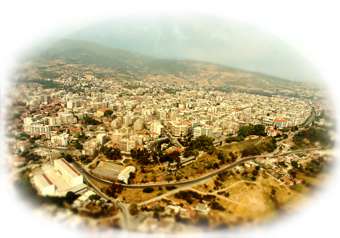Veria
 Veria is the Capital of prefecture of Imathia and its population is about 50000.
Veria is built on the eastern slope of Mt Vermion, on a small plateau. It has a history of at least 2700 years, bearing all this time the same name! Veria’s pre-history goes back well into mythical times: Herodotos writes of the ancient legends, according to which the ancient Macedonians, on their arrival to Veria, arrested Dionysus’ friend and follower, Seilinos, in the famous gardens of King Midas. Those gardens were supposed to be at the foot of Mt Vermion, where wild, incredibly sweet-smelling roses used to grow.
Veria is the Capital of prefecture of Imathia and its population is about 50000.
Veria is built on the eastern slope of Mt Vermion, on a small plateau. It has a history of at least 2700 years, bearing all this time the same name! Veria’s pre-history goes back well into mythical times: Herodotos writes of the ancient legends, according to which the ancient Macedonians, on their arrival to Veria, arrested Dionysus’ friend and follower, Seilinos, in the famous gardens of King Midas. Those gardens were supposed to be at the foot of Mt Vermion, where wild, incredibly sweet-smelling roses used to grow.
Veria’s most glorious period was the one under the last dynasty of Macedonians, Antigonides, whose origins were from this city. Being very near the Macedonian capital city, Aeges, Veria was able to house the “Macedonian Commons;” it minted its own coins, and hosted athletic events called “Alexandria,” in honor of Alexander the Great.
In Roman times, Veria continued to prosper. A lot of Roman Emperors visited it to attend the local festivities held in their honor. Such an important civic center could not be missed by the Apostle, Paul, who visited it to preach more than once. A Christian Community (Church) was founded here, and the city served as a propagation center to the rest of the Balkans.
During Byzantine times, Veria continued to be an important center, and a series of churches were built, with frescoes from the 11th and 18th centuries: among them the Metropolitan Church (built from 1070 and 1080 A.D), a pride for the history of Art in Veria. Many of these churches are still preserved (48 out of 72), and their impact on the local color is so strong that Veria is also called “Small Jerusalem.” Thirty-nine of those churches are decorated with fantastic frescoes, an object of interest to inquisitive visitors.
Otherwise, Veria is a modern city, but it has preserved a few traditional neighborhoods, like Barbouta (the Old Jewish Quarter), and Kiriotissa Quarter. Its traditional mansions are generally in worse condition than the ones in Kastoria, but, lately, vigorous efforts are being made to renovate a number of them.
Tripotamos River crosses the city and creates many picturesque “corners,” where cafes and restaurants offer an enjoyable pastime.
Another town in the same region is Naoussa, with its well-known waterfalls, fruit production, and carnival festival. Near Naoussa is the village Lefkada, where Macedonian tombs and remnants of Hellenistic buildings have been excavated.
Nine kilometers (5.6 miles) northeast of Veria, in the village of Nea Nikomedea, a 7th millennium Neolithic settlement has been excavated, which, together with Sesklo in Thessaly, are the most ancient agricultural settlements in Europe.
The 5-kilometer long Seli Gorge and the “Saranda Ondathes” caves are of great interest to international and Greek trekkers.